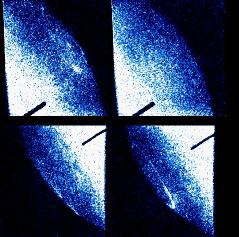

NOTE: Click on the image to view it at its highest resolution.
ESA Faint Object Camera images with HST of the Jovian aurorae on July 13th 1994. Left: 14:55 - 15:29 UT, right: 21:24 - 21:53 UT. Upper panel: north polar region, lower panel: south polar region.
Two pairs of images (north pole and south pole) have been taken 5 hours apart in
search of the signature of the interaction of the dust in the leading wing of
Comet Shoemaker-Levy 9 with the plasma in the Jovian magnetosphere . The
longitude of the central meridian (about 180 degrees in the left panel, and
about 20 degrees in the right panel) correspond to the best visibility
conditions of the north and south aurorae, respectively. The white to blue
continuum is the contribution (in the wing of the filters) of near UV solar flux
reflected by the Jovian atmosphere. The aurorae, due to the excitation of the
upper atmospheric hydrogen by the magnetospheric particles are visible as ovals
on the upper left and lower right images, and just at the limb in the lower left
image. The extreme spatial resolution of the FOC after the implementation of
COSTAR allows to note how narrow these arc are, especially the one in the
Southern aurora which looks as a necklace ( 100 - 200 km). In these images, the
north aurora is particularly faint, and in addition much fainter than the south
aurora (an uncommon behaviour). This fading and the north to south ratio will be
studied in relation with the passage of the comet dust in the Jovian
magnetosphere. Weak north aurorae were also recorded simultaneosuly in far UV
spectra taken with IUE and interpreted together with the FOC images.
![]() Images, Images, Images
Images, Images, Images
